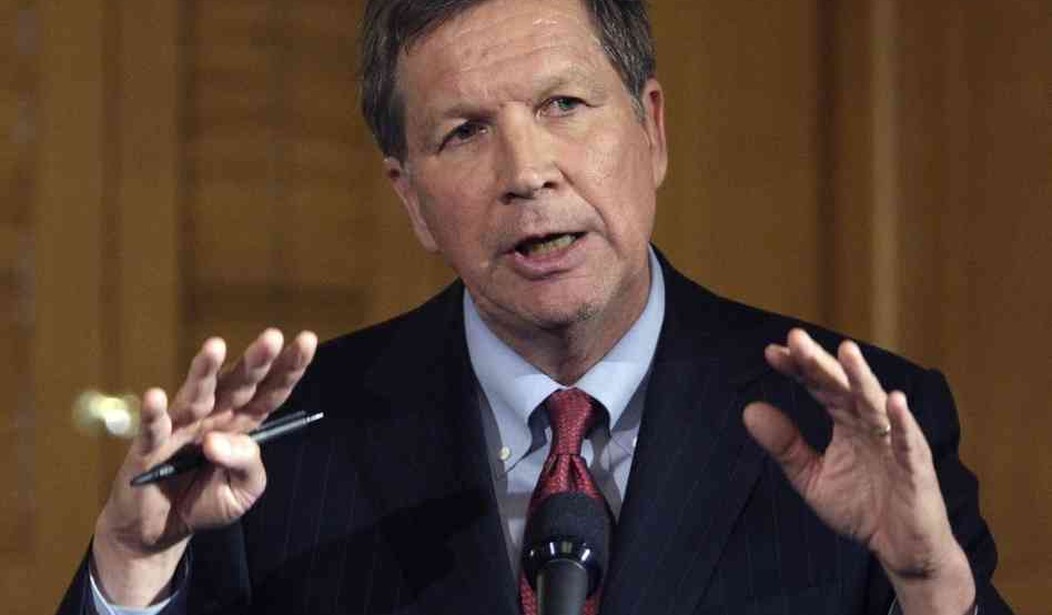In battleground Ohio, an uneventful May 6 gubernatorial primary placed incumbent Republican John Kasich and Democrat Ed FitzGerald on the November ballot.
Gov. Kasich went to Congress in 1982, served as House budget chairman during President Clinton’s first term, and won the governorship during the 2010 midterms. He stumbled early after pushing through a partisan bill that outlawed collective bargaining for state employees. The public backlash peaked with a statewide repeal.
His opponent, Cuyahoga County Executive Ed FitzGerald, from the Cleveland area, has taken aim at Kasich in a progressive, labor-friendly campaign. This 45-year-old former FBI agent and prosecutor defeated Dayton candidate Larry Ealy, a former stripper with a long rap sheet of minor offenses, by 83 to 17 percent, but Ealy colored some otherwise low-key political pages in the process. Kasich had no Republican challenger.
The better-financed Kasich used his non-primary to remind voters of his basic roots and to publicly take credit for Ohio’s improving economy.
One 60-second ad titled “Lift” places the casually dressed governor in a living room, mantle in view, explaining his modest upbringing and economic advancements on his watch. “My parents always taught me that those people who are hurting we need to help,” he says, looking at the camera.
Kasich never lets people forget he’s the son of a mailman and that he wants to champion the underdog, reminiscent of George W. Bush’s 2000 compassionate conservative campaign.
A cursory glance at pre-and-post-Kasich economic numbers has him sitting pretty. State unemployment went from 9.1 percent at his inauguration to 5.7 percent this past April. “When I came in we were down 350,000 jobs,” he says in the ad. “And now we’re up almost a quarter of a million, and I think we’re just scratching the surface.” The language of the campaign is “Ohio’s comeback,” “innovation,” “job-creation,” and “business climate,” with an emphasis on better mental health and addiction treatment.
Have Kasich’s policies made a difference? He likes to say, “The proof is in the pudding.”
Ohio went from 48th in the nation in job creation to fifth. And the state has replenished its rainy day fund to the tune of $1.4 billion. If those numbers don’t spike the pudding, the Kasich camp is armed with additional ones that check out at the Bureau of Labor Statistics.
“He’s made the right decisions to balance the budget, and job creators are now active in Ohio,” declares Connie Wehrkamp, the governor’s campaign communications director.
He has cut personal income taxes by 9 percent already. He made conservatives happy by eliminating the state inheritance tax. And with government revenue increases and some cuts, he eliminated an $8 billion shortfall to create a $1.5 billion surplus. He’s one of the Republican governors who accepted federal Medicaid funding a la the Affordable Care Act. He supported a recent and successful statewide initiative to enable the state to sell bonds for more infrastructure improvements.
How much credit does Kasich deserve for the improvements? Ohio started to feel some relief before he took office. The unemployment rate had moved from 10.6 percent to 9.1 percent in the year before his inauguration.
“The economy of any state has a complex makeup,” says Andy Doehrel, president of the Ohio Chamber of Commerce. “But certainly the business climate created recently by state government is a big part to Ohio’s improvements.”
Doehrel attributes Kasich’s creation of JobsOhio, a private, nonprofit agency that supports Ohio businesses and attracts others to the state, as the chief contributor. “I think it has really put a fresh face on the state,” he says. “It sent a message that it’s not business as usual in Ohio.” Indeed, in 2013, JobsOhio assisted business to create 18,000 jobs and to keep another 70,000 in the state. The organization claims to have created 5,722 jobs in the first quarter this year.
To no surprise, Ed FitzGerald is Kasich’s biggest critic. At his primary election victory speech, the Democratic nominee sarcastically declared, “All of those who haven’t been invited to John Kasich’s miracle economy, we’re going to speak up for you.”
Among the stats the campaign spotlights is that the family poverty rate for Ohio held steady during Kasich’s initial years in office. A 60-second FitzGerald spot titled “Not Working” points to Kasich raising taxes on the middle class while cutting taxes for the wealthy.
A simple analysis sheds some light on the income tax changes. An individual earning $300,000 per year paid $14,898 (5 percent of their income) before Kasich’s cut and paid $13,401 (4.5 percent) after. One earning $50,000 went from paying $1,442 (2.9 percent) annually to paying $1,298 (2.6 percent). A worker earning only $15,000 per year had paid $200 (1.3 percent), and now pays $180 (1.2 percent). The marginal tax rate in Ohio is 5.3 percent.
The Democratic challenger also points to the governor’s cut to local governments and school districts. This has decreased the number of firemen, police, and teachers. It has also shrunk local services, and forced new levies.
Asked if such cuts were worth stripping local governments, “We at the state level tightened the budget,” Wehrkamp defended. “We saved by making tough decisions. Government at all levels need to think outside the box to balance their budgets.”
Fiscal conservatives question the governor’s commitment and don’t think he has gone far enough. “He’s done more than any recent governor,” acknowledges Greg Lawson, an economic policy analyst at the Buckeye Institute, a free market think tank in Columbus. “Has he taken Ohio where it needs to be?” he asks rhetorically. “There’s some question to that.”
Tea Party groups raged when the governor took the federal Medicaid dollars. Some on the left and right call Kasich a “tax shifter.”
Whether he deserves credit for Ohio’s recent economic progress or blame for the negative indicators, in conventional elections, the incumbent governor owns the economy. And right now it is assisting his lead. Most recent measures show Kasich ahead of FitzGerald.
On primary election day, 435,266 Ohio Democrats voted for one of the Democratic candidates, while 554,592 Republicans cast votes for Kasich. A May 16 Quinnipiac University poll shows the governor with a 56 percent approval rating, his best ever, and ahead of FitzGerald by 15 points (Kasich is up 9.5 points in the current Real Clear Politics average). And Kasich leads 49 to 32 percent among independent voters.









Join the conversation as a VIP Member